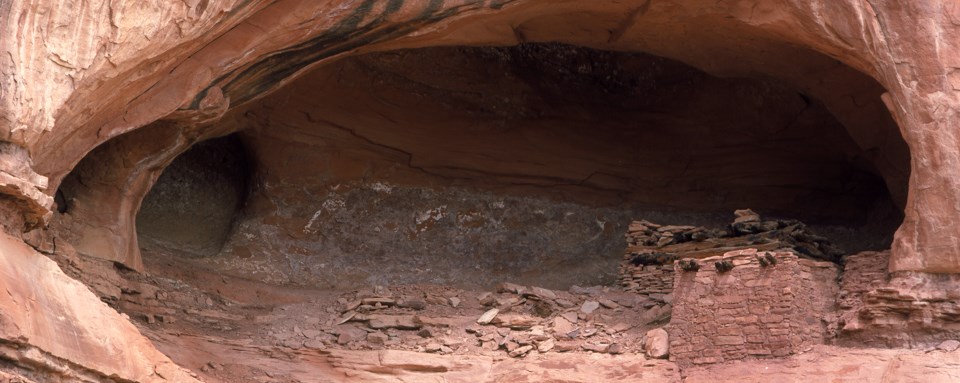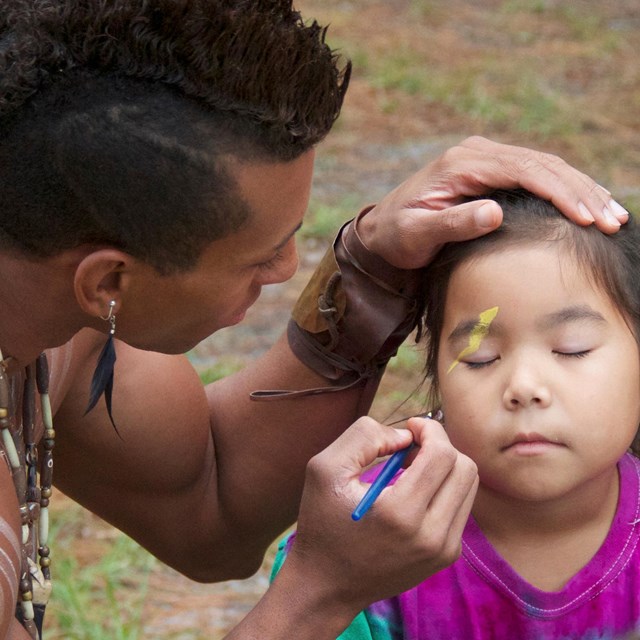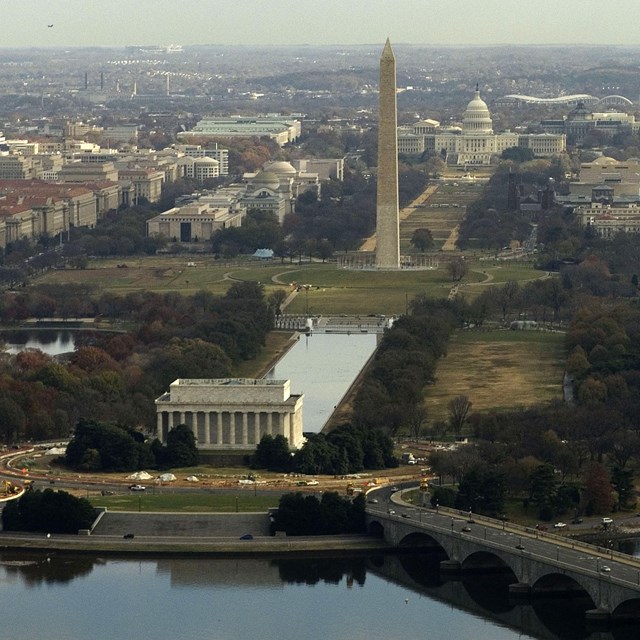Last updated: April 29, 2025
Article
On the Edge: A Visit to Tower Ruin

NPS/Neal Herbert
by Karen Schlom
I've always been afraid of heights. With gut wrenching ferocity the realization came back to me as I squatted at the outermost edge of the alcove containing the Tower Ruin archeological site. Staring down at the thirty-foot drop separating me from the safety of the sandstone bench below, I contemplated four hopelessly small footholds pecked into the rock. This was where I was supposed to place my feet for the descent. Installed by the ancestral Puebloans hundreds of years before, they marked the only feasible route back to home, work, life and lunch.
Two weeks earlier, when the park archeologist invited me to assist with a survey of Tower Ruin, I’d briefly recalled my acrophobia. But the lure of being able to climb into one of the best-known Indian dwellings in the park was overwhelming. Normally, entry into an archeological site within Canyonlands National Park is prohibited for visitors and rangers alike by the Archeological Resources Protection Act. In spite of the law, however, grave robbing, pot hunting, graffiti and artifact theft continue. Therefore, periodic surveys of sites like Tower Ruin are conducted to determine whether or not any impact has occurred. After a second’s hesitation, I accepted.
Visiting someone’s home even when they’ve been gone for centuries still provides a strong impression of how they lived. The folks occupying Tower Ruin selected a neighborhood offering both beauty and practicality. Commanding a spectacular view of Horse Canyon, the site caught the morning sun, benefited from the natural shelter of a rock overhang, and was adjacent to water and arable land. Questions about the people who had made this their home bubbled out.
“Do we know who lived here?” I asked the archeologist.
“Most likely a family group,” she replied. “Large civilization centers such as Mesa Verde would have been occupied year round. Here, homes were probably lived in seasonally by farmers migrating between Horse Canyon and the mesa tops above.”
I examined a flake of chert lying on the ground at our feet. One side was concave indicating percussion by humans. Bits of charcoal also poked up through the sand, and broken corncobs rested on the surface.
“The entire area around these structures was pretty much a midden pile,” the archeologist was saying. “The easiest place to throw garbage was out the door. Notice the dark soil where organic material has decomposed, evidence of a fire pit, and pottery fragments.”
The archeologist inspected the main structure inside the alcove. From close up I could see how the stones had been shaped and fitted to form walls adjoining at right angles. Several thick log beams covered with smaller branches, juniper bark and mud thatching formed the roof. A few holes gaped where the mortar had collapsed, and some of the roof beams had fallen in.
“Carbon dating of the beams indicates Tower Ruin was occupied sometime between A.D. 1220 and 1280.” I heard the archeologist say. “Notice how the pinyon logs supporting the roof are blackened, but not all the charred sides are in a downward position. This suggests that the structure was burned prehistorically, then the same logs reused later.”
“Why?” I asked.
“Most ancestral Puebloan home sites seem to have been burned every fifteen or twenty years,” she answered. “Perhaps this was due to infestations of vermin. With garbage heaps and food items around, insects and rodents would have been a problem. A few years after being burned, the structures were often reoccupied. In this case, the roof beams were reused. This means the builders had most likely run out of good timber. Pinyon and juniper take a long time to grow in the desert and with the number of people occupying these canyons, wood was probably becoming scarce.”
“How many people do you think lived in this area?” I asked.
“It’s hard to say. Most archeologists look at the number of structures and tend to estimate high. What you need to realize, though, is that not all of the houses were occupied at the same time. I’d say perhaps a few hundred people in Salt Creek and Horse Canyon at most.”
I thought about how even centuries ago people had overused certain natural resources in response to population needs. Maybe some of the lessons learned by people of the past should be passed along to those living today.
Then I began to wonder what other experiences we might have in common with the ancestral Puebloans. Had they been afraid of climbing into and out of their home like I was?
“How long did the average person live?” I asked seeking a clue to the dangers these people had faced. “That depended upon gender. Men typically lived to be in their thirties. The average life span for women was around twenty. Childbirth was the primary cause of mortality in females, but if a woman survived her childbearing years she had a good chance of reaching fifty or even sixty.”
“Did they fall much?” I inquired timidly.
“Fell, got bashed with things, and bopped each other over the head. Traumatic injury was by far the most common health problem. One skeleton of a sixty-year-old female studied at Mesa Verde showed she had broken nearly every major bone in her body at least once,” the archeologist said.
This definitely made my fears pale by comparison. After an hour of work the site had been thoroughly examined.
“No evidence of recent human impact,” the archeologist pronounced. “The structural damage, lack of surface artifacts, and soil disturbance we’ve seen today goes way back. Most artifacts with any value were dug up and carted off before the establishment of the park.”
I felt discouraged. “So, how many undisturbed archeological sites do you think there are left inside Canyonlands?”
“None,” she responded. “With aerial looting and modern climbing equipment, all of our archeological sites have probably been compromised.”
An eerie sensation passed over me that the very essence of these people’s lives had been vacuumed clean by the hand of humanity. I thought for a while before asking the next question.
“Does that mean we should give up trying to protect these places?”
“Of course not,” the archeologist replied. “There is still much to be saved. Just look at Tower Ruin. After everything it’s been through most of the buildings are still standing, still beautiful, still holding onto secrets of the past that we don’t yet know how to decipher. But our task for today is completed. It’s time to go down.”
Then I was there at the edge of the cliff staring at the footholds, my stomach tied in knots. In retrospect, this was the experience of a lifetime. A thrilling peek into the lives of people long departed. At that moment, however, all I was could think about was how to convince my knees to stop shaking. I’d probably be up there still if three strong young employees hadn’t helped me down. They definitely earned their salaries that day.
After I reached the security of the slickrock bench below I gazed once more into the alcove. Mortared walls still standing strong seven and a half centuries after their construction. The archeologist was right. Tower Ruin was definitely worth saving.


